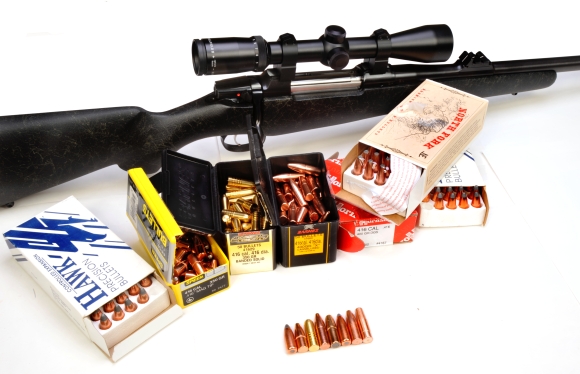
After months of carrying and shooting the Kevlar stocked CZ 550 American Safari Magnum, I’ve come to the conclusion I like this gun, a lot, or I wouldn’t still be carrying and shooting it after all this time. I can usually go from excitement over a new gun to boredom in the course of a week or two, but the CZ has left a favorable impression. For one thing, it’s one of the few guns I have shot lately that feels like a comfortable big game hunting rifle…balanced, shaped and sized to hold onto and quick to the shoulder. That’s saying something when it comes to near ten pound rifles. I could visualize the Safari Magnum in a gun rack on the wall of a wilderness cabin, waiting to be picked up for a morning hunt, then dragged through a harsh environment and inclement weather on its way to bringing down a big bear or moose. And if I were still athletic, and if I still had shoulders, and still enjoyed walking about in a world of nature’s acute inclined planes, I would be do just that.
Yes, I am aware that this rifle is chambered for the .416 Rigby, which may seem more in keeping with an African dangerous game hunting setting, but I like to think of hunting as a solitary endeavor so North America works fine for me. The CZ has left me with the impression that whatever game is hit and downed, it will not likely consider getting up again and that seems appropriate for big and dangerous North American game, as much as it does for big and dangerous African game.
And what about recoil…you big girl
I’ll begin by taking back that reference as there are lots of women who can handle the Rigby, and probably kick my ass for that matter. So let’s just say, don’t be so…fragile, the CZ doesn’t need the adrenalin rush of a cape buffalo charge to mask traumatic recoil. This is the part where I am suppose to write about the difference in acceleration curves amongst a population of cartridges and why a small bore mean spirited cartridge can smack the shooter and beat him black and blue while a monster big bore will brush the shooter’s shoulder like a breath of Irish Spring. Yeah, well, that’s all crap and I have no idea what brain trust came up with the theory. Yeah, I understand the concept. The bigger gun’s bullet accelerates more slowly and therefore it will feel like a push rather than a smack. Below are the acceleration curves of two rounds that are often compared in this way, where the .300 Winchester Magnum is often thought to be the punishing round and the .375 H&H the more gentle recoiling round.
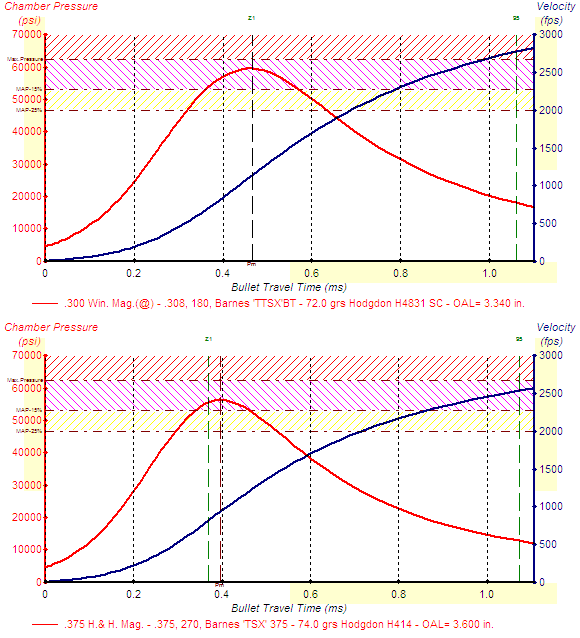
In reality, if you track the scale on the graphs, there is pitiful difference between the two cartridges in terms of time and acceleration. Yes, you heard me, pitiful. I believe the QuickLoad recoil analysis presents the results in data form that is easy to follow.
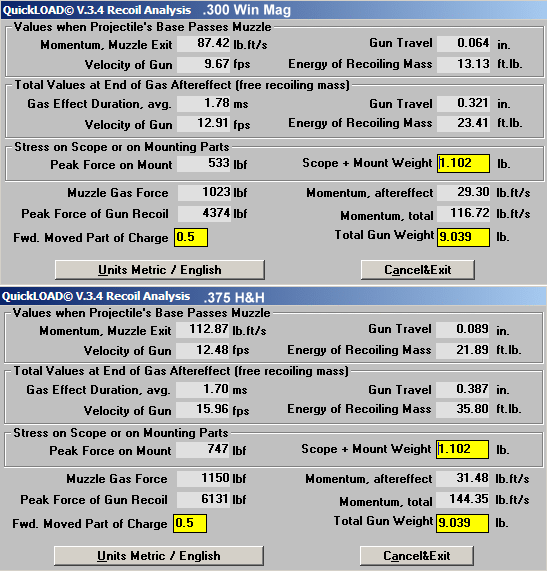
The .375 H&H as a cartridge, rather than a component of a firearm system, kicks harder, faster, and longer than the .300 Winchester Magnum. Put them in the same weight and model gun and the .375 H&H will smack the stuffing out of you more than the gun chambered for the .300 Winchester Magnum. Why am I writing all of this? To point to the fact that it is the specific rifle system design that is the greatest determining factor as to how much recoil a shooter will feel and all .416 Rigby guns are not created equal in that regard. The CZ’s moderate heft, combined with a highly absorbent recoil pad, an aluminum frame secured within energy absorbing Kevlar and fiberglass, a pull length that doesn’t hyperextend the shooter’s rotator cuff, and relatively straight stock geometry to retard muzzle climb, does an outstanding job of harnessing this big cartridge.
After shooting fifty rounds of full tilt .416 Rigby loads this morning, I didn’t feel pushed around, and I am not saying that because I’ve lost all feeling in my body. Shooting from standing, sitting, kneeling or even prone positions, the CZ 550 managed the gun’s peak 99 ft/lbs of recoil to the point recoil was a non-issue. So before getting wound up about big cartridge recoil and summoning five high school physics teachers to join your protesting choir, try shooting a CZ 550 Magnum. You may be pleasantly surprised.
OK, Comparatively Shorty, take a hike. Not so fast there, Elvis…
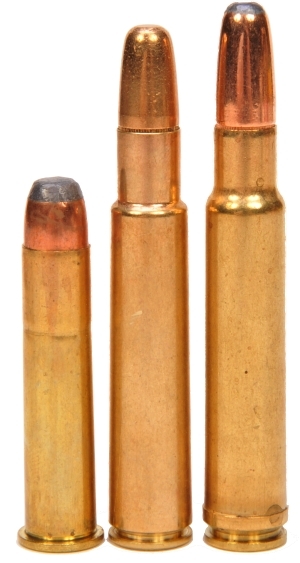
The venerable .45-70 Gov’t with its anemic 79 grains of capacity can, from a Ruger No.1 with the right barrel, push a 405 grain bullet to 2,200 fps*. By comparison, a .416 Rigby factory 410 grain load uses its 127 grains of case capacity to attain 2,370 fps, or just 170 fps faster. The .416 Weatherby, with a 400 grain bullet, can churn up 2,700 fps from 140 grains of capacity. Expressed as muzzle energy, they produce 4,300 ft/lbs, 4.990 ft/lbs and 6,477 ft/lbs respectively. The .45-70 and .416 Rigby are close in performance and, with the right bullets, a .45-70 could be carried right alongside those chaps carrying .416 Rigbys.
I know, Sydney Fogglebottom III, Royal Navy Ret, one of the Queen’s third cousins and famous writers says the Rigby is the only choice for dangerous game on the Dark Continent and would suggest the .45-70 Gov’t round is for American cowboys. I beg to differ and would stick with science in this case rather than celebrity conjecture. Throw a baseball 100 MPH, it doesn’t matter who threw the ball, it is still traveling 100 MPH.
I am not advising that the .45-70 is an optimal choice for hunting elephant. I am merely trying to point out how softly loaded the .416 Rigby is in factory form and that there is a great deal of untapped potential. I do this to head off the ninnies who will counter my comments with talk of a “proper .416 Rigby”, as though the cartridge were a religion. All things old don’t have to be revered.
Harnessing the power of the .416 Rigby for good…
The maximum pressure for the .416 Rigby is approximately 47,000 PSI by specification, the maximum pressure for the .416 Weatherby is approximately 63,000 PSI by specification. It is the gap between these pressure levels, and a couple of grand in U.S. dollars, that separates the performance of the two cartridges. By spec, capacity differences between the two rounds is thirteen grains, however, wet measurement of once fired examples of these cases shows the real world difference to be closer to half that amount. The Weatherby does not excel in velocity as a result of greater powder capacity, but rather from stuffing in more powder into approximately the same volume case and running up the pressure. The pressure restrictions imposed on the .416 Rigby are, in modern applications arbitrary and possibly capricious. I’m sure lesser quality manufacturing and materials, the effect of high ambient temperature on early propellants and a need for a rifle that would never fail to feed and eject while far from civilization all properly contributed to the cartridge’s 1911 specifications. Times have changed, however, and most of those issues are no longer relevant.
Today, manufacturers are making the best rifles of all time, smokeless powders are incredibly stabile even when exposed to a wide range of ambient temperatures and quality of manufacture, materials and design have made high operating pressures ordinary in highly reliable firearms. The CZ 550 Magnum action, with massive receiver and 1,100″ barrel shank, is beefier than a Weatherby Mark V and there is no belt cut in the chamber to thin walls and create weak spots at the case head. Strong enough to handle heavily loaded .500 Jeffery rounds, it is easily strong enough to narrow the performance gap between the .416 Rigby and .416 Weatherby. In conjunction with the CZ 550 American Safari Magnum, the Rigby can be loaded down, or up, to match the specific application and a hunter would be prepared for any of the larger and largest game.
What does $18 worth of bullets look like?
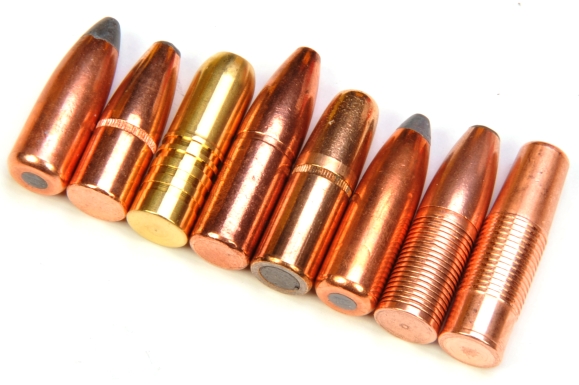
I’m kind of a .416″ fan so there always seems to be a decent selection of bullets laying around. Some are traditional, some not so much. Some made to expand to baseball size in moderately soft tissue, some intended to drill holes through cape buffalo shoulder bone. …pardon the use of tired colloquialisms, I was just putting myself to sleep with some of my verbiage. The bullets are listed below, top to bottom as they appear above, left to right. Now that was fun.
| Bullet | Bullet Type | $ Cost Per |
Shank Diameter |
Bullet Length |
Bullet Weight |
Rigby COL |
Bullet Application |
| Hawk | Soft Point 0.050″ jacket | 1.18 | 0.4165 | 1.277 | 350 | 3.625 | Largest NA and African Plains |
| Speer | Soft Point | 0.70 | 0.4155 | 1.240 | 350 | 3.360 | Largest NA and African Plains |
| Barnes | Banded Solid | 1.10 | 0.4150 | 1.305 | 350 | 3.625 | Elephant – Cape Buffalo |
| Barnes | Monolith Copper | 1.12 | 0.4155 | 1.565 | 400 | 3.625 | Cape Buffalo |
| Hornady | Copper Clad Steel – Hard Lead Core | 0.70 | 0.4155 | 1.396 | 400 | 3.370 | Elephant – Cape Buffalo |
| Hawk | Soft Point 0.050″ jacket | 1.30 | 0.4165 | 1.429 | 400 | 3.625 | Cape Buffalo |
| North Fork | Monolith Copper Cup Point Solid | 1.90 | 0.416 | 1.500 | 400 | 3.625 | Elephant – Cape Buffalo |
| North Fork | Solid Shank Soft Point | 1.68 | 0.416 | 1.468 | 400 | 3.625 | Largest NA – Cape Buffalo |
| Dimensions in inches, weight in grains – average of ten samples | |||||||
The .416 Rigby can be handloaded for a wide variety of applications. The data that follows covers some of my initial work with the cartridge. Those that are below 47,000 PSI are in keeping with CIP published pressure guidelines. Those above 47,000 PSI, but below 60,000 PSI are well above published spec pressure levels. However, in my own opinion and assessment, they are workable in strong actions like the CZ 550 Magnum.
| Bullet Type |
Bullet Weight Grains |
COL” | Powder Type |
Powder Charge Grains |
Muzzle Velocity FPS |
Muzzle Energy Ft/Lbs |
Pressure PSI |
| Hawk Soft Point | 350 | 3.625 | H414 | 93.0 | 2546 | 5039 | < 47,000 |
| H4350 | 102.0 | 2779 | 6002 | < 60,000 | |||
| Speer Soft Point | 350 | 3.630 | H4350 | 90.0 | 2441 | 4632 | <47,000 |
| H4350 | 102.0 | 2761 | 5925 | <60,000 | |||
| Barnes Banded Solid | 350 | 3.625 | Re 19 | 100.0 | 2589 | 5208 | <47,000 |
| Re 19 | 107.0 | 2779 | 6003 | <60,000 | |||
| Barnes TSX | 400 | 3.650 | IMR 7828 | 94.0 | 2395 | 5095 | <47,000 |
| IMR 4350 | 91.0 | 2551 | 5779 | <60,000 | |||
| Hornady | 400 | 3.600 | Re 19 | 93.0 | 2392 | 5084 | <47,000 |
| Re 19 | 100.0 | 2572 | 5873 | <60,000 | |||
| Hawk Soft Point | 400 | 3.625 | IMR 7828 | 97.0 | 2409 | 5177 | <47,000 |
| Re 19 | 100.0 | 2575 | 5888 | <60,000 | |||
| North Fork Copper Cup | 400 | 3.625 | AA MagPro | 102.0 | 2435 | 5266 | <47,000 |
| H4350 | 95.0 | 2601 | 6009 | <60,000 | |||
| North Fork Solid Shank SP | 400 | 3.625 | Re 22 | 97.0 | 2432 | 5252 | <47,000 |
| IMR 4350 | 93.0 | 2558 | 5812 | <60,000 |
But Joe, did you learn anything from this…
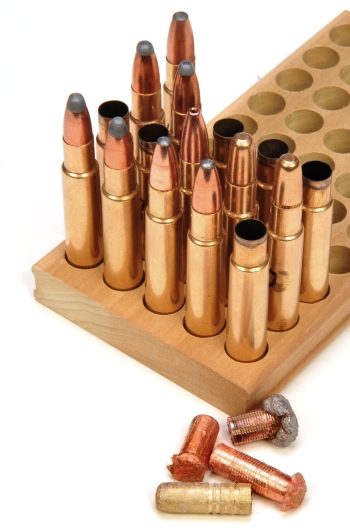
OK, let me think for a moment…
Observations – Not a flat primer, stuck case, ballooned case head or case of erratic velocity in the bunch. As I noted earlier, recoil with this rifle is moderate and I would guess negligible under hunting conditions. Muzzle climb is minimal, muzzle blast is substantial, feed and eject was uneventful; cartridges went in easily and they came out the same way. It was easy to shoot the big .416 accurately to the point 1½” groups were common place and some a tad better. Not a bad varmint rifle. The Rigby did something a recent .45-70 heavy load exercise didn’t, it produced ballistic pressure waves or a strong hydraulic force that is not typical.
Penetration testing at Real Guns is routinely done with 8″ Sona tube filled with plastic containers filled with wet and compacted test medium. This time around, it was not possible to fire into the medium at fifteen yards without bursting plastic containers and blowing out sona tube walls. Solids generated as much hydraulic force even when little expansion occurred. I’ve not had this happen before, even with heavier cartridges, so it was interesting to observe. The reason this occurred is…I have no idea. The test medium was mixed as always, the saw dust component came from the same supply and it was left to set up and saturate for the same period of time. The short term solution was to change to packed 12″ Sona tubes filled with the same material and then excavate the mess to recover bullets.
Long bullets were seated quite deep, which was not of consequence as the capacity surrendered would not interpret into a potential to use a slower powder or greater charge even if recovered. I am sure for moose and bear basically anything on the list would work. The Hawk Dead Soft bullets grow to a huge size without shedding more than 10% – 15% of their original weight. I think a typical Hawk mushroomed bullet, 400 grain type, was over an inch in diameter. The downside of the expansion was less penetration, something on the order of 20″.
Down to four, then two…

The bullets that got my interest the most were the: Barnes the Barnes Banded Solid, North Fork Cup Point, North Fork Solid Shank Soft Point. Depth of penetration for the higher pressure loads noted above was approximately 3″- 4″ greater than the lesser pressure loads. Wanting to settle on two bullets, the TSX was discounted because of insufficient expansion for the depth of penetration. The North Fork Cup Point was discounted because expansion was minimal, always to one side and the bullets tracked through the medium in that direction. I concluded by selecting the Barnes Banded Solid for penetrating work and the North Fork Solid Shank Soft Point for everything else. Both bullet types, within those applications, have been very consistent in performance.
| Bullet | Penetration inches |
Mushroomed diameter |
Original Weight |
Recovered Weight |
| Barnes TSX | 32″ | 0.583 | 350 | 304 |
| Barnes Banded Solid | 56″ | 0.408 | 350 | 345.2 |
| North Fork CP | 42″ | 0.573 | 400 | 388.2 |
| North Fork | 28″ | 0.785 | 400 | 357.0 |
Flat shooting…
.416 Magnums shoot flat, the result of capacity, aerodynamics, high sectional density and a solid ballistic coefficient. The following are some examples of what can be expected from this cartridge without a whole lot of handloading effort.
 |
|||||||||||||||||||||||||
|
|||||||||||||||||||||||||
|
|||||||||||||||||||||||||
|
|||||||||||||||||||||||||
|
|||||||||||||||||||||||||
 |
|||||||||||||||||||||||||
|
|||||||||||||||||||||||||
|
|||||||||||||||||||||||||
|
|||||||||||||||||||||||||
|
|||||||||||||||||||||||||
 |
|||||||||||||||||||||||||
|
|||||||||||||||||||||||||
|
|||||||||||||||||||||||||
|
|||||||||||||||||||||||||
|
|||||||||||||||||||||||||
 |
|||||||||||||||||||||||||
|
|||||||||||||||||||||||||
|
|||||||||||||||||||||||||
|
|||||||||||||||||||||||||
|
|||||||||||||||||||||||||
 |
|||||||||||||||||||||||||
|
|||||||||||||||||||||||||
|
|||||||||||||||||||||||||
|
|||||||||||||||||||||||||
|
|||||||||||||||||||||||||
 |
|||||||||||||||||||||||||
|
|||||||||||||||||||||||||
|
|||||||||||||||||||||||||
|
|||||||||||||||||||||||||
|
|||||||||||||||||||||||||
 |
| B.C. data not available and ogive and cup tip too unique to attempt closest fit calculations |
 |
| B.C. data not available. Form is close to 400 grain Speer SP, but not close enough to attempt calculations |
The North Fork bullets I’m sure are fine for their applications when it comes to BC. The solid shank soft point, in particular appears to have a slippery ogive even with the flat tip. I just don’t like to use BC profiles and guess the performance of a companies product as the result is very nice looking tables with absolutely bad information.
Fun project. Good shooting and well made firearm. The .416 Rigby is an interesting intersection of big gun power and flat shooting capability. There are lots if bullets available in .416″ and there are lots of powder types that work really well for this combination. The rifle is no more costly than any decent standard cartridge bolt action rifle, even though it is a premium product. Outside of brass, the .416 isn’t particularly costly to handload and the savings over factory ammo are astronomical. If you have a need for one big gun, or your just a firearm enthusiast who likes to blow over targets and do so at a healthy distance, this is a combination to check out.
After handling a good number of CZ rifles, I’ve found them to be well made, reliable, accurate and reasonable in cost. It’s tough for a company to make solid hunting pieces such as this American Safari Magnum right along side some fancy grade walnut stocked gems, and still turn out deer and varmint rifles, all with good quality, but CZ-USA has managed to do so.
The .416 Rigby CZ 550 American Safari Magnum Part I
The .416 Rigby CZ 550 American Safari Magnum Part II

Email Notification